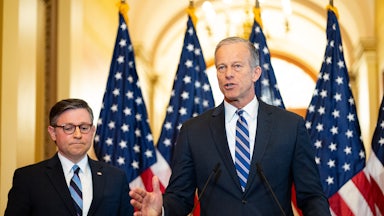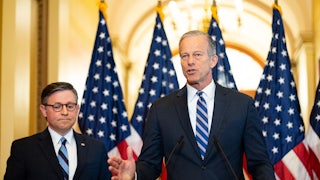Harvard President Alan Garber stated Monday that he would not comply with the Trump administration’s outrageous list of demands, which include reporting to the federal government the identities of foreign students “hostile to the American values and institutions inscribed in the U.S. Constitution and Declaration of Independence,” a ban on face masks, “reducing the power held by students and untenured faculty,” and sharing “all hiring and related data” with the feds.
“No government,” Garber answered in his prepared statement, “should dictate what private universities can teach, whom they can admit and hire, and which areas of study and inquiry they can pursue.” The Trump administration responded immediately with a freeze on more than $2 billion in grants. President Donald Trump even threatened on Truth Social to take away Harvard’s tax-exempt status.
Garber’s statement made me proud to be a Harvard College graduate (class of 1980). “Not since,” I found myself thinking … and then I stopped. When was Harvard’s finest hour before this? Certainly not last month, when Harvard broke off a research partnership with Birzeit University in the West Bank and removed the two leaders of its Center for Middle Eastern Studies. That was very much the opposite: obeying in advance.
More than other universities, Harvard is expected to issue moral edicts all the time, but until now these pronouncements were cost-free. In February 2022, Harvard denounced Russia’s invasion of Ukraine because, sure, why not. In September 2021, Harvard announced its divestment of fossil-fuel investments, which sounded slightly self-sacrificing, but the truth was fossil fuels were no longer a particularly profitable investment. Forty-nine years have passed since I matriculated, and during all that time I never once heard anybody refer to any kind of “finest hour.” Until now. Did Harvard have one before it stood up to Trump?
Yes, it turns out, more than 200 years ago. But I’m getting ahead of myself. I scribbled down six instances of moral challenge since Harvard’s founding in 1636. Then I started phoning and emailing historians and various others who were Harvard experts to ask how Harvard met these moments. Here are my findings.
Salem witch trials. Harvard’s involvement here was minimal, but not helpful. In 1689, Cotton Mather published a book titled Memorable Providences, Relating to Witchcrafts and Possessions that helped create hysteria by alleging instances of “Bewitched or Possessed persons in New-England.” The Salem accusations surfaced three years later. Mather was a Harvard graduate, but more significantly, he was the adult son of Harvard President Increase Mather (after whom Harvard’s present-day Mather House is named).
Father and son urged “exquisite caution” in Salem, according to an October 2019 article in the Harvard Crimson by Juliet Isselbacher. But they also urged “speedy and vigorous prosecution.” More laudably, Increase wrote: “It is better that a Guilty Person should be ABSOLVED, than that he should without sufficient ground of Conviction be condemned.” But that was in a tract that (according to Isselbacher) wasn’t published until after 20 Salem witches had been hanged. Whoops.
Slavery and the Civil War. Three years and two Harvard presidents ago, a university committee issued a report on Harvard’s legacy of slavery. For 147 years after its founding in 1636, Harvard administrators, faculty, and staff enslaved more than 70 people. The university and its donors also maintained “extensive financial ties to slavery,” principally in the Caribbean. In 1850, Harvard Medical School admitted three free Black students, but after objections from alumni and students, the school’s dean, Oliver Wendell Holmes Sr. (father of the jurist) cravenly expelled them.
After passage of the Fugitive Slave Act in 1850, antislavery activity surged, especially in Boston, home to the antislavery Senator Charles Sumner and the abolitionists William Lloyd Garrison and Wendell Phillips. But according to the 2022 report, “support for antislavery efforts remained anemic at Harvard.” According to Andrew Schlesinger, author of Veritas: Harvard College and the American Experience (2005), when Ralph Waldo Emerson gave a speech in Cambridge against the Fugitive Slave Act, a group of Southern law students jeered him. “After making each point,” Schlesinger wrote, “Emerson paused to let the storm of hisses subside.” After Abraham Lincoln was elected president, Harvard’s Southern students returned home.
Harvard students and faculty fought bravely for the Union. A “Harvard regiment” (the 20th Massachusetts Volunteer Infantry) suffered more casualties than almost any other. Robert Gould Shaw (Harvard 1860; no degree) famously led the 54th Massachusetts Volunteer Infantry, the first all-Black regiment. After the war, Harvard built a grand Romanesque building, Memorial Hall, to commemorate the university’s 176 Union dead. But that didn’t constitute any act of bravery on the part of university administrators.
Red Scare One. This refers to the post–World War One panic over Bolsheviks and anarchists, some of whom engaged in genuine acts of terror. To his credit, Harvard President A. Lawrence Lowell resisted pressure from the university’s board of overseers to fire the radical lecturer Harold Laski for supporting the 1919 Boston police strike. “If the Overseers ask for Laski’s resignation,” Lowell said, “they will get mine!”
But Lowell’s more lasting legacy was to lead the Lowell Commission, a three-person group appointed by Massachusetts Governor Alvan T. Fuller to advise him on whether to spare the lives of the anarchists Nicola Sacco and Bartolomeo Vanzetti, who’d been convicted for murder on extremely flimsy evidence in a trial rampant with judicial misconduct. Sacco and Vanzetti were almost certainly innocent, but the commission, which Lowell dominated, recommended that the execution go ahead. The columnist Heywood Broun (Harvard ’10; no degree) later commented, “What more can these immigrants from Italy expect? It is not every prisoner who has a president of Harvard University throw on the switch for him.” Broun recommended that “the institution of learning in Cambridge, which once we called Harvard, be known as Hangman’s House.”
Red Scare Two. Another split decision. On the one hand, Harvard Magazine editor John Rosenberg told me (reading over the phone from former Harvard Magazine editor John T. Bethel’s 1998 book, Harvard Observed), Harvard President Nathan Pusey was judged by Senator Joe McCarthy to be a reprehensible “anti-anti-communist.” When McCarthy came after a Harvard associate professor of physics named Wendell Furry, Pusey refused to fire him, which showed courage. Instead, Pusey called a press conference in Massachusetts Hall and said that no member of the Communist Party was fit to be a member of Harvard’s faculty, but he was not aware that any were.
The Berkeley sociologist Robert Bellah (Harvard 1950) said in a 2005 letter to The New York Review of Books that Harvard’s reputation for saying the wrong thing while doing the right thing was, in his experience, charitable. In the fall of 1954, Bellah wrote, while he was a graduate student in sociology and Far Eastern languages, he was called into the office of McGeorge Bundy, then dean of Harvard’s faculty of arts and sciences. Bundy told him he’d learned Bellah had been a member of the Communist Party and that Bellah would be obliged to name names to the FBI. Bellah replied that he’d be glad to discuss his own activity (he was indeed a member from 1947 to 1949) but that he wouldn’t identify others. That’s what Bellah did when the FBI picked him up off the street a few days later.
Bundy told Bellah that in refusing to name names he was putting in danger the Harvard fellowship that was the sole financial support for him, his wife, and his young daughter. Bellah was later told by a Harvard mentor that he’d better finish his dissertation quickly because his fellowship wouldn’t be renewed for the next school year. Bellah followed that advice and graduated in June 1955. He was then offered an assistant professorship, but only on condition that, if called to testify before Congress about his Communist activities, he would answer every question. Bellah took a job at McGill instead. Two years later, after the heat was off, Bellah accepted a position at Harvard, where he rose to full professor before decamping to Berkeley.
Taking into account his experience as well as Furry’s in his New York Review letter, Bellah concluded:
What all this amounts to is a record not of Harvard’s being a bulwark against McCarthyism, but of abject cowardice, of a willingness to cooperate completely with the FBI and with McCarthy and McCarthyite committees, tempered only by a concern that the Harvard administration not do something that would rouse even more criticism than not cooperating with McCarthy would, such as firing someone with tenure.
That’s a severe judgment, but one that Bellah certainly earned.
The Vietnam War. Harvard dismantled the Reserve Officers’ Training Corps at the insistence of participants in the 1969 Harvard strike. But that didn’t really cost Harvard anything except disgruntlement from a small minority of students. Within a few years, Harvard students who wanted to be in the ROTC were permitted to train at MIT, a short subway ride away, and in 2011 the ROTC was permitted back on the Harvard campus.
Some Harvard professors of government traveled to Washington to give Henry Kissinger a piece of their mind about the Vietnam War, putting at risk at most a few consulting contracts. Michael Kinsley (Harvard 1972), who would later be editor and columnist at The New Republic, followed along and wrote a hilarious send-up for the Harvard Crimson (part one, part two).
The Revolutionary War. Let’s bring all suspense to an end. Harvard’s sole significant display of institutional bravery prior to this week was during the American war for independence. “They stood tall,” Schlesinger told me. In May 1775, students were sent home so college buildings could be turned into a barracks for 1,600 soldiers. (Classes resumed that fall in Concord, Massachusetts.) George Washington took command of the Continental Army on Cambridge Common, a stone’s throw from the college, and settled into a house on Brattle Street. “Boston was occupied by British troops,” Schlesinger said. “They were just across the river.”
I relate these episodes at length not to undermine Harvard but to underscore the unusual nature of Garber’s stance. What’s especially notable is that most of these earlier episodes took place before the federal government, at the instigation of Vannevar Bush, became a major funder of university research. (During the McCarthy period, this had scarcely begun.) “A private university like Harvard is naturally conservative, and inclined to support what the government wants,” Holly Brewer, a professor of American history at the University of Maryland, told me. But the pressure Trump is applying to Harvard is unprecedentedly foul. It’s good to see my alma mater stand up to it. Let the bivouac in Harvard Yard resume.






